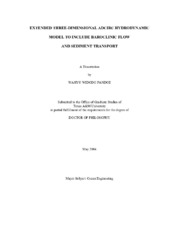| dc.contributor.advisor | Edge, Billy L. | |
| dc.creator | Pandoe, Wahyu Widodo | |
| dc.date.accessioned | 2004-09-30T01:43:38Z | |
| dc.date.available | 2004-09-30T01:43:38Z | |
| dc.date.created | 2003-05 | |
| dc.date.issued | 2004-09-30 | |
| dc.identifier.uri | https://hdl.handle.net/1969.1/143 | |
| dc.description.abstract | The objective of this research is to identify the circulation patterns of the water and sediment fluxes in coastal and estuarine zones, where the shoaling processes correlate with tide generating flow patterns. The research provides a better understanding of the characteristics of spatial and temporal variability of currents. An important deviation from previous research is the inclusion of the baroclinic term, which becomes very important in density driven flows. The understanding of this process provides a basis for determining how the water circulation three-dimensionally controls the hydrodynamics of the system and ultimately transports the suspended and soluble materials due to combined currents and waves. A three-dimensional circulation model is used to calculate the water circulation. The model is based on the three-dimensional (3D) version of Advanced Circulation (AD-CIRC) Hydrodynamic Model with extending the Sediment Transport module. The model is based on the finite element method on unstructured grids. The output of the hydrody-namic model is used to estimate spatial and temporal advections, dispersions and bottom shear stress for the erosion, suspension, deposition and transport of sediment. The model development includes extending the existing three-dimensional (3D) ADCIRC Model with (1) baroclinic forcing term and (2) transport module of suspended and soluble materials. The transport module covers the erosion, material suspension and deposition processes for both cohesive and non-cohesive type sediments. The inclusion of the baroclinic demonstrates the potential of over or underpredicting the total net transport of suspended cohesive sediment under influence of currents. The model provides less than 6% error of theoretical mass conservation for eroded, suspended and deposited sediment material. The inclusion of the baroclinic term in stratified water demonstrates the prevailing longshore sediment transport. It is shown that the model has an application to the transport of the cohesive sediments from the mouth of the Mississippi River along the north shore of the Gulf of Mexico towards and along the Texas coast. The model is also applicable to determine the design erosion thickness of a cap for isolating contaminated dredged material and to evaluate the appro-priate grain size of cap sediments to minimize the erosion. | en |
| dc.format.extent | 7160801 bytes | en |
| dc.format.extent | 241025 bytes | en |
| dc.format.medium | electronic | en |
| dc.format.mimetype | application/pdf | |
| dc.format.mimetype | text/plain | |
| dc.language.iso | en_US | |
| dc.publisher | Texas A&M University | |
| dc.subject | Three-dimensional hydrodynamic | en |
| dc.subject | finite telement | en |
| dc.subject | baroclinic | en |
| dc.subject | sediment transport | en |
| dc.subject | ADCIRC. | en |
| dc.title | Extended three-dimensional ADCIRC hydrodynamic model to include baroclinic flow and sediment transport | en |
| dc.type | Book | en |
| dc.type | Thesis | en |
| thesis.degree.department | Civil Engineering | en |
| thesis.degree.discipline | Ocean Engineering | en |
| thesis.degree.grantor | Texas A&M University | en |
| thesis.degree.name | Doctor of Philosophy | en |
| thesis.degree.level | Doctoral | en |
| dc.contributor.committeeMember | Chen, Hamn-Ching | |
| dc.contributor.committeeMember | Randall, Robert E. | |
| dc.contributor.committeeMember | Brooks, David A. | |
| dc.type.genre | Electronic Dissertation | en |
| dc.type.material | text | en |
| dc.format.digitalOrigin | born digital | en |


